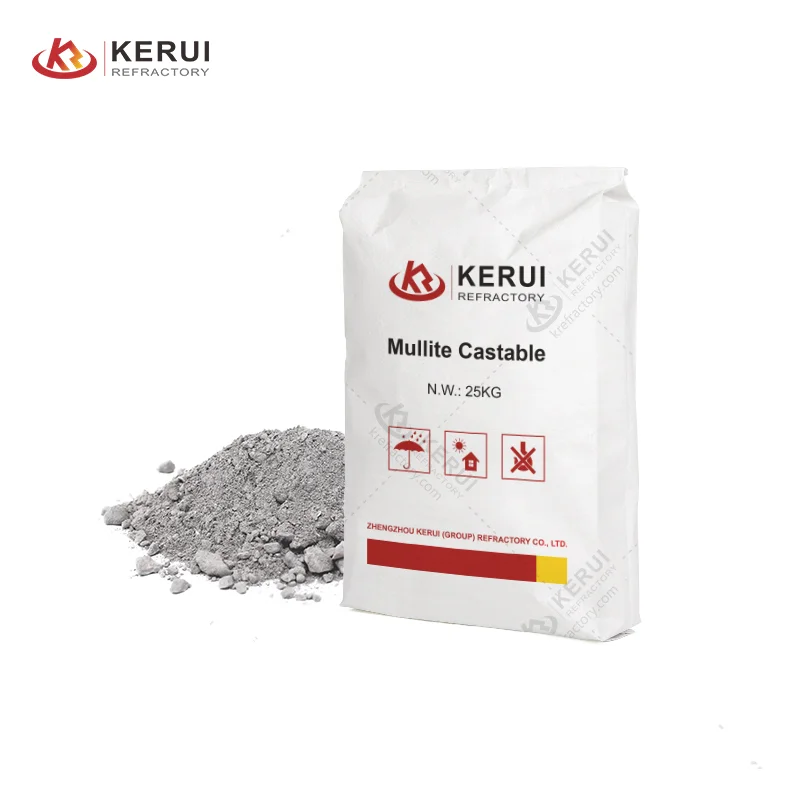Navigazione tra gli articoli
- What Makes Castable Cement a Supermaterial?
- Types & Their Secret Weapons
- Industry-Specific Power Moves
- Smart Buying Hacks for Maximum ROI
- Why Kerui Dominates the Arena
1. What Makes Castable Cement a Supermaterial?
Refractory castable cement is a high-temperature concrete engineered to withstand extreme heat (up to 1,800°C/3,272°F) while maintaining structural integrity. Composed of aggregates (corundum, bauxite), binders (calcium aluminate), and additives, it combines rapid installation with unmatched versatility. Kerui’s castables deliver:
- Monolithic Magic: Seamless linings eliminate weak joints prone to slag penetration.
- Thermal Shock Immunity: Survive 50+ rapid cooling cycles (ΔT >1,000°C).
- Custom Sculpting: Mold complex geometries like kiln arches or burner nozzles in hours.
2. Types & Their Secret Weapons
2.1 I Vendicatori incasellabili
| Tipo | Caratteristiche principali | Temperatura massima | Star Application |
|---|---|---|---|
| Materiali colabili a basso contenuto di cemento | Al₂O₃ 70–85%, porosity <15% | 1,650°C | Steel ladle linings, blast furnaces |
| Self-Flowing Castables | Zero vibration, fills 1mm gaps | 1,600°C | Complex preheater cyclones |
| Materiali colabili potenziati con SiC | SiC 20–30%, abrasion resistance 3x steel | 1,500°C | Cement kiln transition zones |
| Materiali isolanti in castables | Thermal conductivity 0.3–0.8 W/m·K | 1,200°C | Energy-efficient boiler backs |
Kerui KR-SF90 Self-Flow Castable reduces installation time by 70% vs. traditional methods.



3. Industry-Specific Power Moves
3.1 Steel & Metallurgy
- Electric Arc Furnace Roofs: Low-cement castables withstand 1,700°C molten steel splashes:.
- Tundish Linings: Self-flowing variants eliminate cracks in curved geometries.
3.2 Cement & Lime
- Rotary Kiln Inlet Cones: SiC castables combat alkali sulfate erosion.
- Raffreddatori di clinker: High-alumina castables (Al₂O₃ ≥80%) resist abrasive particles.
3.3 Petrolchimico
- Cracker Furnace Floors: Ultra-low cement castables thrive in hydrogen-rich environments.
- Pile di bengala: Thermal shock-resistant grades handle -50°C to 1,400°C swings.
4. Smart Buying Hacks for Maximum ROI
4.1 Price vs. Performance Breakdown
| Grado | Gamma di prezzi (FOB) | Lifespan* | Ideale per |
|---|---|---|---|
| Standard (Al₂O₃ 60%) | $150–400/ton | 6–12 months | Small furnaces, repairs |
| Premium (Al₂O₃ 80%) | $400–700/ton | 12–24 months | Steel ladles, kiln hot zones |
| Kerui KR-LC85 | $700–1,300/ton | 18–30 months | Heavy-industry critical zones |
*Compared to traditional firebricks
4.2 5-Step Procurement Strategy
- Sample Smart: Test 50kg batches for workability and curing time.
- Certification Check: Demand ISO 9001 and ASTM C113/C133 reports.
- MOQ Negotiation: Bulk orders (20+ tons) secure 8–15% discounts.
- Logistics Wins: Choose suppliers with DDP terms and damage-proof packaging.
- Tech Support: Partner with R&D-backed manufacturers (e.g., Kerui’s 160+ engineers).
5. Why Kerui Dominates the Arena
5.1 Bordo dell'innovazione
- Tecnologia Nano-Bond: Reduces porosity to 12% for molten metal resistance.
- AI-Driven Formulations: Custom blends optimized for your kiln’s thermal profile.
5.2 Global Triumphs
- Studio di caso: A Brazilian steel mill boosted ladle lifespan by 40% using Kerui’s KR-LC85.
5.3 Risk-Free Guarantees
- 24/7 Engineer Hotline: Troubleshoot mixing/vibration issues in real-time.
- 30-Day Replacement: Defective batches replaced, no questions asked.
Ready to Revolutionize Your Thermal Systems?
Data validated per ASTM standards. Results may vary—consult Kerui’s engineers for project-specific solutions.



